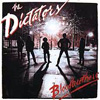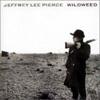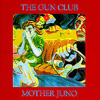|
|
|
||
| home | table of contents |feature | record reviews | live shows | news | events |archive | record label | links | contact | ||
|
THE
GUN CLUB
As for being the Gun Club’s most representative record, all of the elements from various incarnations of the band can be found here – Fire Of Love driving blues-based punk romps, Miami-esque jangly western-tinged pop anthems, The Las Vegas Story’s rootsy eclecticism, Wildweed’s new waveyness, and some of the hard rock leanings that become more pronounced with Pastoral Hide and Seek and particularly Divinity. Sonically slicker than its predecessors, Mother Juno’s big hard rock production is further accentuated by the new loud and clear mastering. On the surface, a middle-of-the-road rock record, the multilayered collection has a deep end, which becomes more visible with each listen. In the tradition of The Las Vegas Story, the hard rock is mostly rootsy in the cowpunk sense of the word, but also contains blues, soul, jazz, swamp, surf, and new wave elements. Mother
Juno was the Gun Club’s first release since 1984’s
The Las Vegas Story and, for all intensive purposes –
a reunion record. The band reached a peak of popularity with the
album and the tour that followed. Consistent with the Gun Club’s
pattern of lucklessness, their label, England’s Red Rhino,
collapsed a few months after Mother Juno’s release.
The album resurfaced on Thirsty Ear in 1996 and Buddha in 2000 before
its reissue this month on Sympathy. The CD also includes bonus tracks
“Crabdance”
and “Nobody’s
City,” both of which initially appeared on the
B-side of the “Breaking Hands” twelve-inch. Like Iggy Pop’s Lust for Life and The Idiot, Bowie’s Berlin trilogy, the entire 80s Bad Seeds output, and a good hunk of Neubauten’s discography, Mother Juno was recorded at “the big wall by the wall,” Berlin’s legendary Hansa Studios. The Gun Club selected Hansa because Kid Congo Powers had moved to Berlin to join Nick Cave and the Bad Seeds. Initially considering New Order’s Peter Hook for production duties, the band decided on an equally odd choice for a loud guitar-driven record - the Cocteau Twins’ Robin Guthrie. By this point in their careers, self-taught Jeffrey Lee Pierce and Kid Congo Powers have firmly established their unique musical styles and apply them masterfully to this batch of songs. Pierce’s whisper/croon/sing/scream/howl is not only a more subtle and in tune than on past efforts, but also weaves itself into a wider variety of phrases, textures, and tones. He still pulls a bit of a Morrison in his lower range, but as always is unmistakably himself – particularly when he opens up his throat, let’s the wind from his belly blow through, and takes his trademark vocals to a higher pitch. Credited with “Guitars, Slide, Feed Back,” Kid Congo Powers offers no shortage of the fluid ambient guitar soundscapes and feedback drenched solos for which he is best known. The opening tracks “Bill Bailey” and “Thunderhead,” two of the rawest rockers since Fire of Love, are both rootsy punk numbers. “Bill Bailey” builds tension with a rigid driving rockabilly beat and, in the Gun Club tradition, blows wide open on the chorus and bridge. “Thunderhead’s” two most memorable parts are Kid’s whammy and slide noise in the breakdown and Pierce’s shift into an Elvisy vibrato in the last line of the song. “Lupita Screams,” which still takes some getting used to on my part is the heaviest and most metallic song on the album, and perhaps in the entire catalogue - it is almost Dio-esque. While Powers’ big distorted guitar emits pseudo-metal solos and riffage, the spirit of Scorpions vocalist Klaus Meine sneaks into Hansa and enters Pierces’ body. While they were trying to rock hard, I assure you that these were not the bands they were emulating. The album shifts down gears for “”Yellow Eyes” and “The Breaking Hands.” In the former, Mori and Sanderson lay a foundation with a slow smoky soul groove as Powers cuts a chorus-laden new wavy yet Cropperesque figure in both the rhythm and the solo. This gives fellow Bad Seed Blixa Bargeld, the guest guitarist on the track, a chance to do Powers’ usual job of laying down the ambient wallpaper. In a first-class post-punk guitar lesson, the troubled sleep is broken as the guitars get up with the shakes and engage in an artfully panned battle. “The Breaking Hands,” with its soft and highly layered Cocteau Twins shimmer, is the one track that clearly shows the mark of producer Robin Guthrie. A hazy wall of slide guitars and synthesizers float above and around this mid-timpoed pop song completely unique to the Gun Club discography. “Araby’s” breakneck triplets accelerate the pace to new levels. As the horse chase rumbles by, a giant poppy chorus tears the composition open in the fashion of “Bill Bailey”. The western feel is further accentuated by Powers ghostly reverbed-out whammy surf guitar on the breaks. “Hearts,” an intense burst of sentimentality not unlike some of Patti Smith’s melodic/melodramatic three-chord anthems, contains Powers’ best and spookiest ambient guitar. After the punk of “My Cousin Kim,” Mother Juno winds up with the brilliant power ballad “Port of Souls." Lyrics and Thematic Material Claus Castenskiold, who painted the covers of The Fall’s The Wonderful and Frightening World of the Fall, Perverted By Language, and This Nations Saving Grace, also did the cover to Mother Juno. As the dour sleepless face of the man behind the wheel stares into the distance, the woman in the passenger seat covers her face and peeks out at him from underneath her hands. The driver has a bottle in his hand and another on the seat. Dice hang from the rearview mirror and a dashboard Jesus has his face covered by a black cloth execution style. The woman in Castenskiold painting looks on in horror as the man casts their collective fates to the wind. Here again Pierce, this time at the peak of his lyrical abilities, remains the poet of hopelessness. Yet instead of focusing on acts of debauchery and violence that mark Pierce’s previous work, Mother Juno’s melancholy fatalism is more about 1) futile descents into oblivion and 2) the acceptance of cruelty, betrayal, and abandonment in both life and love. The numb characters can’t rescue themselves from downward spirals. Though a significant other accepts the faults of “Bill Bailey” and begs to go along for the hell-ride, the protagonists of the remainder of the album are left alone to die as their lovers walk away to save themselves. Water is the most common motif in Mother Juno. And the water is that which stains, that which can’t be held, and moreover, that which drowns. Water is appears in every song except for “Cousin Kim,” which, with contains all fire imagery. The record begins when Bill Bailey’s lover tries to save him from the water - ordering him to “get out of the sea” and “crawl up and go back home.” Thunderhead, who left the protagonist alone, lost her mind, and lives in the street, “went wild across the sea.” The narrator tells Lupita, a down and out junkie, “The river’s got your forehead.” He adds that “New York houses pain and boredom in between the seas.” Yellow Eyes’ daddy-boy has “gone under water” – explaining that “his other side just took over.” Though “the sun and sea are smiling” in the opiated dreamscape of “The Breaking Hands,” it is a mirage as the narrator wishes “Allah would will me a piece of iron in my head.” In “Araby” “the rain just slaps our faces / colors me to here / where do we go? / where’s the train?” Next in “Hearts,” water is amorphous and impossible to contain. “Hearts, with love like water / Hearts, with love that goes.” Finally, in “Port of Souls,” Pierce’s farewell, he is drowned - “too much ocean, too much sea, it’s no wonder that you buried me.” Consistent with the Gun Club’s overall body of work, Mother Juno references to American song to enforce its themes. “Bill Bailey,” whose woman, as in Hughie Cannon’s 1902 minstrel standard, wants her loser boyfriend back, is, according to Pierce’s autobiography Go Tell the Mountain, about Pierce’s friend Nick Cave – who also shows up on .While the lyrics to the chorus share the same primary line with the 1902 song, “Bill Bailey won’t you come home”, Pierce’s heroine, instead of begging “please come home” and offering to do the laundry and pay the rent, orders her “pale and useless” man to “shut up and come back home tonight.” Like the Modern Lovers’ “She Cracked,” “Thunderhead” is an abandoned man’s account of a wild ex-girlfriend losing her mind. Other than the unreliable narrator technique applied to a lover’s insanity, Jonathan Richman’s “she’d eat garbage, eat shit, get stoned” and Pierce’s “she sleeps in garbage/ Oh Shit! Should I be alone” are put across with the exact same phrasing. As is Richman’s heroine understanding “the European things of 1943” and Pierce’s crawling “over her head backwards like it was 1963. Finally, “Port of Souls” is peopled with American folk song characters. The first line, “Run Molly Run” is the title of a song about an old horse who is supposed to take her last breath in a race with a younger horse, but at the end surprises everyone by winning. Pierce, who would never go for a happy ending, is of course only teasing the listener with the promise of beating the odds. Rose Connelly, who winds up in the bottom of the river, murdered by her lover in the traditional folk song “The Willow Garden,” appears in the fourth verse. The final folk figure to show up is the “steel driving man” who also appears in Fire of Love’s “For the Love of Ivy,” John Henry. As the mountain sinks in on John Henry in the popular folk song of the same name, Mother Juno’s protagonist loses the battle with “too much ocean, too much sea and finds himself buried in the “Port of Souls.”
© New York Night Train , 2005
|




